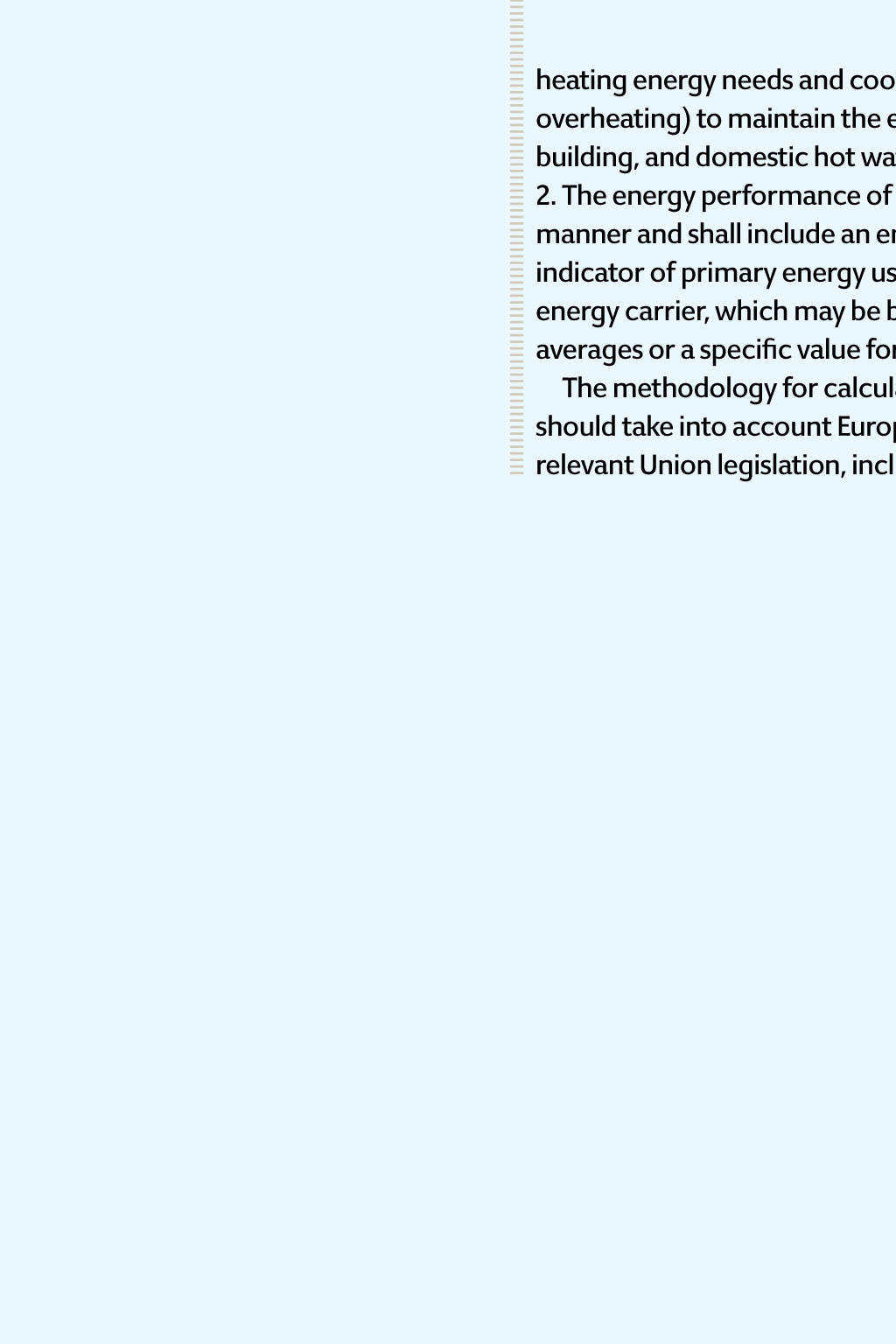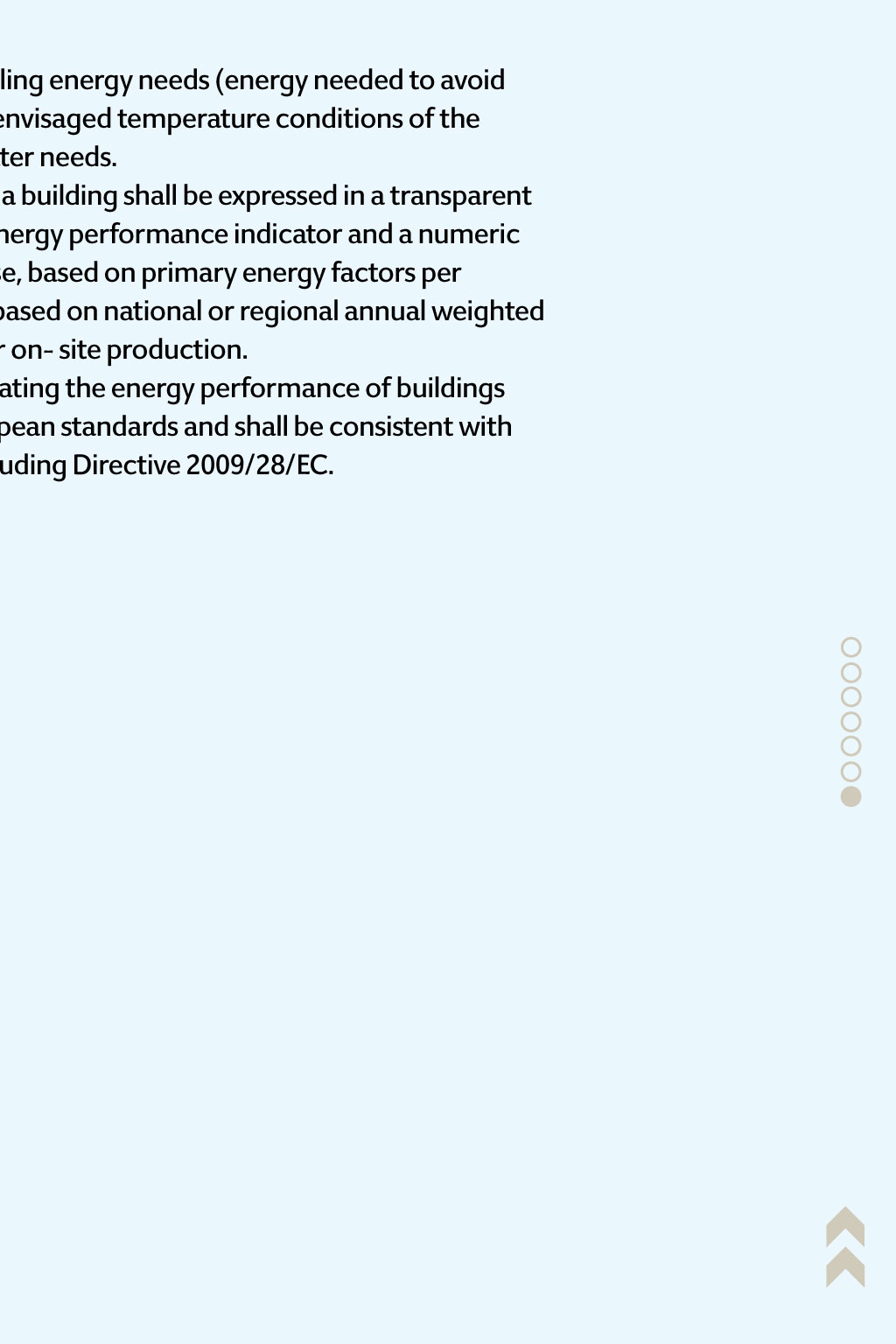




























Opinion: regulations maintaining standards Knowledge of new standards is essential if engineers are to stay at the top of their game. Hywel Davies flags up revisions to those supporting the European Energy Performance of Buildings Hywel Davies, technical director of CIBSE www.cibse.org European standards can creep up on the building services industry The Energy Performance of Buildings Directive (EPBD) sets out the terms for calculating and certifying the energy performance of buildings. It is the reason for whole-building calculations and for Energy Performance Certificates. It sets requirements for member states to follow, even if it allows them some discretion to specify the details. One of these requirements relates to the way that energy performance is calculated. Under Article 3, member states must apply a methodology for calculating the energy performance of buildings in accordance with the common general framework set out in Annex I. It provides for the methodology to be adopted at national or regional level which is just as well because it allows for separate regulations and standards in the four parts of the UK. Annex I sets out a Common general framework for the calculation of energy performance of buildings, which covers heating, cooling, domestic hot water, lighting, insulation, internal loads and air-tightness. It stipulates that member states methodology should take into account European Standards and relevant EU legislation, including [the Renewables Directive]. The energy performance directive does not require member states to adopt European Standards, but there is an increasing tendency for the EU to use standards to support the implementation of European legislation. Although member states currently have scope to adopt their own methods, that scope is increasingly constrained by emerging standards. As well as adopting the EPBD in 2003, the Commission instructed the European Standards body, CEN of which the British Standards Institution (BSI) is the UK member to develop a set of standards on the calculation of energy performance. The first instruction was issued in 2004, and the standards were published in 2007-8. In 2010, when the recast EPBD was adopted, CEN was issued with further instructions to revise the original standards. This took the form of a standardization mandate for the elaboration and adoption of standards for a methodology calculating the integrated energy performance of buildings and promoting the energy efficiency of buildings, in accordance with the terms set in the recast of the Directive. Since then, CEN has been busy working on the revised standards, and the first drafts are now out for public enquiry. This may not seem to be of the most immediate concern to CIBSE Journal readers. However, these standards have a habit of creeping up on the industry. Under public procurement law, public purchasers are expected to specify by reference to standards and, as the BSI has to adopt all European Standards as British Standards, they find their way into public purchasing. Under the Construction Products Regulation, CE marking against a European Standard or Technical Approval is now mandatory. So for all the talk of standards being voluntary, they are unavoidable for construction products. The mandate for the energy performance standards says clearly that standards increase the transparency, accessibility and objectivity of energy-performance assessment in the member states, facilitating the comparison of best practice and supporting the internal market for construction products. This sets out a clear direction of travel for the EPBD-related standards. Standards are written by committees, drawn from all of the CEN members, with input from participating standards bodies. They are also open to public enquiry, when anyone is allowed to review the standard and suggest improvements or changes. Once the comments are collected, the technical committee has to work through them and address each one before producing a final draft. Until recently, that would then go for a formal, and final, vote. But now, if there are no significant technical changes at the enquiry stage, that formal vote may not be required. The public enquiry stage is, therefore, very much a case of speak now, or forever hold your peace. CIBSE is represented on the BSI committee responsible for these standards. However, it is neither reasonable nor realistic to expect one volunteer expert to read all the standards, and to anticipate all the potential improvements, and then convey them all to the committee. Public comment is just that, and it is the opportunity for all those who may have an interest to contribute to improving the drafts. Currently, there are a number of drafts dealing with energy performance of buildings, at various stages of public comment. These are all parts of EN 16798, covering various aspects of ventilation and calculations relating to building performance. There are also nine parts of EN 16282, dealing with ventilation of commercial kitchens, which are all out for comment, with a closing date in early March [see panel Current drafts for public enquiry]. For CIBSE to contribute to the development of these standards, we need contributions from members, too. This is a chance to influence what goes into the standards. Miss it and the next chance could be a little while coming around. Current drafts for public enquiry prEN 16282, Equipment for commercial kitchens: Components for ventilation of commercial kitchens This standard is in nine parts, dealing with various aspects of kitchen ventilation, as follows: Part 1: General requirements, including calculation method Part 2: Kitchen ventilation hoods: design and safety requirements Part 3: Kitchen ventilation ceilings: design and safety requirements Part 4: Air inlets and outlets: design and safety requirements Part 5: Air duct: design and dimensioning Part 6: Aerosol separators: design and safety requirements Part 7: Installation and use of fixed fire-suppression systems Part 8: Installations for treatment of cooking fumes: requirements and testing Part 9: Capture and containment performance of extraction systems - test methods See the various parts of EN 16798 in the online version of thisarticle at cibsejournal.com or via the app at cibsejournal.com/app ePBd recast series, as at december 2014 Working group 19 EN 16798-01: Energy performance of buildings Part 1: Indoor environmental input parameters for design and assessment of energy performance of buildings addressing indoor air quality, thermal environment, lighting and acoustics Module M1-6; (revision of EN 15251) TR 16798 -02: Energy performance of buildings Part 2: Indoor environmental input parameters for design and assessment of energy performance of buildings addressing indoor air quality, thermal environment, lighting and acoustics Module M1-6 Technical report: interpretation of the requirements in EN 16798-01 Working group 20 EN 16798 -03: Energy performance of buildings Part 3: Ventilation for non-residential buildings Performance requirements for ventilation and room-conditioning systems ; (revision of EN 13779) TR 16798 -04: Energy performance of buildings Part 4: Ventilation for non-residential buildings Performance requirements for ventilation and room-conditioning systems Technical report: interpretation of the requirements in EN 16798- 03 Working group 21 EN 16798 05-1: Energy performance of buildings Part 05-1: Ventilation for buildings Modules M5-6, M5-8, M6-5, M6-8, M7-5, M7-8 Calculation methods for energy requirements of ventilation and air conditioning systems; (revision of EN 15241) EN 16798 05-2: Energy performance of buildings Part 05-2: Ventilation for buildings Modules M5-6, M5-8, Calculation methods for energy requirements of ventilation systems Part 5-2 Distribution and generation (revision of EN15241) method 2 TR 16798 06: Energy performance of buildings Part 6: Ventilation for buildings Modules M5-6, M5-8, M 6-5, M6-8 , M7-5, M7-8 Calculation methods for energy requirements of ventilation and air conditioning systems; technical report interpretation of requirements in EN 16798-05 EN 16798-07 Energy performance of buildings Part 7: Ventilation for buildings Modules M5-1, M5-5, M5-6, M5-8 Calculation methods for the determination of air flow rates in buildings including infiltration TR 16798 08: Energy performance of buildings Part 8: Ventilation for buildings Modules M5-1, M5-5, M5-6, M5-8 Calculation methods for the determination of air flow rates in buildings including infiltration. Technical report: interpretation of the requirements in EN16798 -07 EN 16798 09 : Energy performance of buildings Part 09: Ventilation for buildings Module M4-1 Calculation methods for energy requirements Calculation methods for energy requirements of cooling systems General TR 16798 10: Energy performance of buildings Part 10: Ventilation for buildings Module M4-1 Calculation methods for energy requirements Calculation methods for energy requirements of cooling systems general Technical report: interpretation of the requirements in EN 16798 09; EN 16798 11: Energy performance of buildings Part 11: Module M4-3 Calculation of the design cooling load TR 16798 12: Energy performance of buildings Part 12: Module M4-3 Calculation of the design cooling load Technical report: interpretation of the requirements in EN 16798 11 EN 16798 13: Energy performance of buildings Part 13: Module M4-8 Calculation of cooling systems Generation TR 16798 14: Energy performance of buildings Part 14: Module M4-8 Calculation of cooling systems generation Technical report: interpretation of the requirements in EN 16798 13 Working group 22 EN 16798 15: Energy performance of buildings Part 15: Module M4-7 Calculation of cooling systems storage General TR 16798 16: Energy performance of buildings Part 16: Module M4-8 Calculation of cooling systems storage Technical report: interpretation of the requirements in EN 16798 15 Working group 23 EN 16798 17: Energy performance of buildings Part 17: Ventilation for buildings Module M4-11, M5-11, M6-11, M7-11 Guidelines for inspection of ventilation and air-conditioning systems TR 16798 18: Energy performance of buildings Part 18 : Ventilation for buildings Module M4-11, M5-11, M6-11, M7-11 Guidelines for inspection of ventilation and air-conditioning systems Technical report: interpretation of the requirements in EN 16798 17 anneX I Common general framework for the calculation of energy performance of buildings (referred to in Article 3) 1. The energy performance of a building shall be determined on the basis of the calculated or actual annual energy that is consumed in order to meet the different needs associated with its typical use and shall reflect the heating energy needs and cooling energy needs (energy needed to avoid overheating) to maintain the envisaged temperature conditions of the building, and domestic hot water needs. 2. The energy performance of a building shall be expressed in a transparent manner and shall include an energy performance indicator and a numeric indicator of primary energy use, based on primary energy factors per energy carrier, which may be based on national or regional annual weighted averages or a specific value for on- site production. The methodology for calculating the energy performance of buildings should take into account European standards and shall be consistent with relevant Union legislation, including Directive 2009/28/EC. "